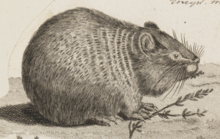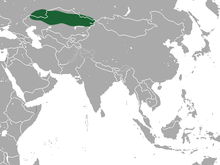A | B | C | D | E | F | G | H | CH | I | J | K | L | M | N | O | P | Q | R | S | T | U | V | W | X | Y | Z | 0 | 1 | 2 | 3 | 4 | 5 | 6 | 7 | 8 | 9
This article includes a list of general references, but it lacks sufficient corresponding inline citations. (October 2020) |
| Steppe pika | |
|---|---|

| |
| Scientific classification | |
| Domain: | Eukaryota |
| Kingdom: | Animalia |
| Phylum: | Chordata |
| Class: | Mammalia |
| Order: | Lagomorpha |
| Family: | Ochotonidae |
| Genus: | Ochotona |
| Species: | O. pusilla
|
| Binomial name | |
| Ochotona pusilla (Pallas, 1769)
| |
| Subspecies | |
| |

| |
| Steppe pika range | |
The steppe pika (Ochotona pusilla) is a small mammal of the pika family, Ochotonidae. It is found in the steppes of southern Russia and northern Kazakhstan.
General description
Ochotonidae includes only one genus - Ochotona, formed by 30 living species. Like rodents, pikas have chisel-like incisor teeth, but they also have a second pair of incisors in the upper jaw, followed by two molar teeth in the upper jaw and three molar teeth in the lower jaw. Pikas have no canines. Their teeth grow throughout their life and they need to be worn down. The anatomical structure of the lower jaw bone makes it possible to move the jaw both up and down and sideways. Pikas have sharp senses, they can smell, hear and see very well. Their fibular bone has partially accreted with the tibia. They have five digits on their limbs and pads on feet and toes. Pikas are not hibernating animals.
The steppe pika is usually 14.5–18.5 cm (5.7–7.3 in) long. The tail is reduced, and the short round ears have a lighter lining. The fur is taupe, with lighter hair ends. The coat becomes lighter in winter. Pikas give birth to up to 13 young in a litter, three to five times a year. The size of the litter may depend on the size of population in the area. One of the most distinctive characteristics of the steppe pika is its short, high-pitched alarm call, which gives the animal the name of the "whistling hare".
The steppe pika has been called a relict of Late Pliocene faunas on the basis of its fossil record, molar structure, karyological traits, and mtDNA sequence data.[2]
Distribution
Steppe pikas can be found in Central Asia, east of the Urals throughout southern Russia and northern Kazakhstan. During the Pleistocene its range was larger and included most of Europe. It survived in the Carpathian basin until the end of the Chalcolithic,[2] in the middle Urals until the Middle Holocene, and in the southern Urals until the Late Holocene.[3]
Ecology
Steppe pika inhabits steppes covered by high grasses and bushes, where it finds shelter from its natural enemies, such as: foxes, corsacs, Turkestan polecats, ermine and other predators. Another of its niches is foothill of river valleys. Unlike other species of the family of pikas, Ochotona pusilla is a nocturnal creature. It is normally heard but not seen. The males emit a long series of low trills and the females do also sing to attract males and respond to other females.[4] It lives in a flock, dwelling systems of underground passages with several openings. Pikas feed on soft parts of juicy plants and low shrubs, near its dens. One of its favorite plants is wormwood. Due to the fact it doesn't hibernate during winter, early (from June) it begins to gather grass, and dry it formed in haystacks. In the late autumn it moves the haystacks to the main chamber of its den.
The steppe pika inhabits only flatlands. Its fossil record in mountain areas is always linked to owl pellets and not indicative of the pika's past habits. Pikas are generally regarded as an excellent indicator of the health of steppe ecosystems, as they strictly avoid human disturbance.[2]
Population and environmental concerns
A decrease has been noted in the population of pikas, caused by climate changes and expanding agriculture. The pica has been included in the list of potentially endangered species but is classified as "least concern". One of the places where it is protected is Orenburgsky Zapovednik. A growing pika population may have a local impact on vegetation through feeding.
References
- ^ Smith, A.T. & Lissovsky, A. (2016). "Ochotona pusilla". IUCN Red List of Threatened Species. 2016: e.T15052A45179445. doi:10.2305/IUCN.UK.2016-3.RLTS.T15052A45179445.en. Retrieved 21 September 2021.
- ^ a b c Németh, A., Bárány, A., Csorba, G., Magyari, E., Pazonyi, P., & Pálfy, J. (2017). Holocene mammal extinctions in the Carpathian Basin: a review. Mammal Review, 47(1), 38-52.
- ^ Kosintsev, P. A., & Bachura, O. P. (2014). Formation of recent ranges of mammals in the Urals during the Holocene. Biology Bulletin, 41(7), 629-637.
- ^ Aulagnier S.; P. Haffner, A. J. Mitchell-Jones, F. Moutou & J. Zima (2009) Mammals of Europe, North Africa and the Middle East, A&C Black, London.
- ADW, 2013.
- http://animaldiversity.ummz.umich.edu/accounts/Ochotonidae/
- http://animaldiversity.ummz.umich.edu/accounts/Ochotona_pusilla/#0a4c74e0589540d73a9589064bd7626e
- Fisher C. T., Yalden D. W., 2004. The steppe pika Ochotona pusilla in Britain, and a new northerly record. Mammal Review. 34(4): 320-324
- Fostowicz-Frelik Ł., Frelik G. J., 2010. The earliest occurrence of the steppe pika (Ochotona pusilla) in Europe near the #Pliocene/Pleistocene boundary. Naturwissenschaften. 97:325-329
- Grzimek B., 1975. Grzimek's animal life encyclopedia. Vol. 12, Mammals 3. Van Nostrand Reinhold, New York.
- Grzimek B., 2004. Grzimek's animal life encyclopedia. Vol. 16: Mammals V. Gale, Detroit.
- Kowalski K., 1971. Ssaki Zarys teriologii. Państwowe Wydawnictwo Naukowe, Kraków.
- Kowalski K., 1991. Mały słownik zoologiczny. Ssaki. Wiedza powszechna, Warszawa.
- Niu Y., Wei F., Li M., Liu X., Feng Z., 2004. Phylogeny of pikas (Lagomorpha, Ochotona) inferred from mitochondrial cytochrome b sequences. Folia Zool. 53(2): 141–155
- Serafiński W., Wielgus-Serafińska E., 1976. Ssaki. Państwowe Wydawnictwo Naukowe, Warszawa.
- Zooschool, 2013, http://zooschool.ru/mouse/leporidae/6.shtml
>Text je dostupný pod licencí Creative Commons Uveďte autora – Zachovejte licenci, případně za dalších podmínek. Podrobnosti naleznete na stránce Podmínky užití.
Wikipedia:Citing sources#Inline citations
Wikipedia:WikiProject Reliability
Wikipedia:When to cite
Help:Maintenance template removal
File:Ochotona pusilla.tif
Conservation status
Least Concern
IUCN Red List
Taxonomy (biology)
Template:Taxonomy/Ochotona
Eukaryote
Animal
Chordate
Mammal
Lagomorpha
Pika
Pika
Binomial nomenclature
Peter Simon Pallas
File:Steppe Pika area.png
Mammal
Ochotonidae
Steppe
Russia
Kazakhstan
Ochotonidae
Relict (biology)
Late Pliocene
Karyology
MtDNA
Central Asia
Urals
Pleistocene
Carpathian basin
Chalcolithic Europe
Holocene
Corsac fox
Steppe polecat
Stoat
Fossil record
Owl pellet
IUCN Red List
Doi (identifier)
Template:Lagomorpha
Template talk:Lagomorpha
Special:EditPage/Template:Lagomorpha
Lagomorpha
Animal
Chordate
Mammal
Eutheria
Euarchontoglires
Pika
Pika
Alpine pika
Helan Shan pika
Collared pika
Hoffmann's pika
Northern pika
Kazakh pika
Pallas's pika
American pika
Turuchan pika
Gansu pika
Plateau pika
Daurian pika
Nubra pika
Afghan pika
Tsing-ling pika
Moupin pika
Thomas's pika
Chinese red pika
Forrest's pika
Glover's pika
Ili pika
Koslov's pika
Ladak pika
Large-eared pika
Royle's pika
Turkestan red pika
Leporidae
Rabbit
Hare
Amami rabbit
Amami rabbit
Riverine rabbit
Riverine rabbit
Nesolagus
Sumatran striped rabbit
Annamite striped rabbit
Volcano rabbit
Volcano rabbit
Pygmy rabbit
Pygmy rabbit
Cottontail rabbit
Andean tapeti
Swamp rabbit
Common tapeti
Dice's cottontail
Central American tapeti
Omilteme cottontail
Marsh rabbit
Suriname tapeti
Coastal tapeti
Venezuelan lowland rabbit
Desert cottontail
Mexican cottontail
Eastern cottontail
Tres Marias rabbit
Mountain cottontail
Appalachian cottontail
Robust cottontail
New England cottontail
Brush rabbit
Oryctolagus
European rabbit
Bunyoro rabbit
Bunyoro rabbit
Red rock hare
Natal red rock hare
Jameson's red rock hare
Smith's red rock hare
Hewitt's red rock hare
Hispid hare
Hispid hare
Hare
Antelope jackrabbit
Snowshoe hare
Arctic hare
Alaskan hare
Mountain hare
Black jackrabbit
Desert hare
Tolai hare
Broom hare
Yunnan hare
Korean hare
European hare
Manchurian hare
Ethiopian highland hare
Ethiopian hare
African savanna hare
Hainan hare
Indian hare
Burmese hare
Chinese hare
Yarkand hare
Incertae sedis
Tamaulipas jackrabbit
Japanese hare
Black-tailed jackrabbit
White-sided jackrabbit
Cape hare
Corsican hare
Tehuantepec jackrabbit
Granada hare
Abyssinian hare
Woolly hare
Scrub hare
White-tailed jackrabbit
Help:Taxon identifiers
Wikidata
Q587278
Wikispecies
Ochotona pusilla
Animal Diversity Web
Barcode of Life Data System
Encyclopedia of Life
European Nature Information System
Fauna Europaea
Fauna Europaea
Global Biodiversity Information Facility
INaturalist
Interim Register of Marine and Nonmarine Genera
Integrated Taxonomic Information System
IUCN Red List
American Society of Mammalogists#Mammal Diversity Database
Mammal Species of the World
National Center for Biotechnology Information
Observation.org
Open Tree of Life
Wikidata
Q122396628
European Nature Information System
Steppe pika
Steppe pika
Main Page
Wikipedia:Contents
Portal:Current events
Special:Random
Wikipedia:About
Wikipedia:Contact us
Special:FundraiserRedirector?utm source=donate&utm medium=sidebar&utm campaign=C13 en.wikipedia.org&uselang=en
Help:Contents
Help:Introduction
Wikipedia:Community portal
Special:RecentChanges
Wikipedia:File upload wizard
Main Page
Special:Search
Help:Introduction
Special:MyContributions
Special:MyTalk
Степна пика
Pika ar stepennoù
Pica d'estepa
Ochotona pusilla
Pišťucha stepní
Steppenpfeifhase
Ochotona pusilla
Ochotona pusilla
Ochotona pusilla
초원우는토끼
Ochotona pusilla
Дала шақылдағы
Kuzol (Ochotona pusilla)
Pika tal-isteppa
السهوب بيكا
Dwergfluithaas
ステップナキウサギ
Szczekuszka malutka
Ochotona pusilla
Малая пищуха
Степска пика
Kääpiöpiiskujänis
Dvärgpiphare
Пискуха степова
Ochotona pusilla
Ochotona pusilla
草原鼠兔
Special:EntityPage/Q587278#sitelinks-wikipedia
Steppe pika
Talk:Steppe pika
Steppe pika
Steppe pika
Special:WhatLinksHere/Steppe pika
Special:RecentChangesLinked/Steppe pika
Wikipedia:File Upload Wizard
Special:SpecialPages
Special:EntityPage/Q587278
Category:Ochotona pusilla
Ochotona pusilla
Steppe pika
Steppe pika
Main Page
Wikipedia:Contents
Portal:Current events
Special:Random
Wikipedia:About
Wikipedia:Contact us
Special:FundraiserRedirector?utm source=donate&utm medium=sidebar&utm campaign=C13 en.wikipedia.org&uselang=en
Help:Contents
Help:Introduction
Wikipedia:Community portal
Special:RecentChanges
Wikipedia:File upload wizard
Main Page
Special:Search
Help:Introduction
Special:MyContributions
Special:MyTalk
Степна пика
Pika ar stepennoù
Pica d'estepa
Ochotona pusilla
Pišťucha stepní
Steppenpfeifhase
Ochotona pusilla
Ochotona pusilla
Ochotona pusilla
초원우는토끼
Ochotona pusilla
Дала шақылдағы
Kuzol (Ochotona pusilla)
Pika tal-isteppa
السهوب بيكا
Dwergfluithaas
ステップナキウサギ
Szczekuszka malutka
Ochotona pusilla
Малая пищуха
Степска пика
Kääpiöpiiskujänis
Dvärgpiphare
Пискуха степова
Ochotona pusilla
Ochotona pusilla
草原鼠兔
Special:EntityPage/Q587278#sitelinks-wikipedia
Steppe pika
Talk:Steppe pika
Steppe pika
Steppe pika
Special:WhatLinksHere/Steppe pika
Special:RecentChangesLinked/Steppe pika
Wikipedia:File Upload Wizard
Special:SpecialPages
Special:EntityPage/Q587278
Category:Ochotona pusilla
Ochotona pusilla
Steppe pika
Steppe pika
Main Page
Wikipedia:Contents
Portal:Current events
Special:Random
Wikipedia:About
Wikipedia:Contact us
Special:FundraiserRedirector?utm source=donate&utm medium=sidebar&utm campaign=C13 en.wikipedia.org&uselang=en
Help:Contents
Help:Introduction
Wikipedia:Community portal
Special:RecentChanges
Wikipedia:File upload wizard
Main Page
Special:Search
Help:Introduction
Special:MyContributions
Updating...x
Text je dostupný za podmienok Creative
Commons Attribution/Share-Alike License 3.0 Unported; prípadne za ďalších
podmienok.
Podrobnejšie informácie nájdete na stránke Podmienky
použitia.


